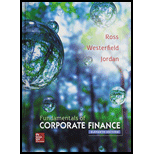
Fundamentals of Corporate Finance with Connect Access Card
11th Edition
ISBN: 9781259418952
Author: Stephen A. Ross Franco Modigliani Professor of Financial Economics Professor, Randolph W Westerfield Robert R. Dockson Deans Chair in Bus. Admin., Bradford D Jordan Professor
Publisher: McGraw-Hill Education
expand_more
expand_more
format_list_bulleted
Question
Chapter 2, Problem 20QP
Summary Introduction
To critically think about: The dividend paying capacity of the firm if the net income is negative and the long-term debt account of the firm if the net capital spending, net working capital, and the new stock issued is zero.
Introduction:
Dividend refers to the payment made by the company to the stockholders’ of the firm. It is the interest earned by the stockholders’ on their capital. The dividend is not a compulsory payment and is paid at the discretion of the company.
Long-term debt refers to the dollars borrowed by the company to obtain financial leverage.
Expert Solution & Answer
Trending nowThis is a popular solution!

Students have asked these similar questions
Hello tutor give correct answer
Need assistance urgently by the expert.
Fake answers will be rate as unhelpful.
please don't use ai and if you cant understand given values please don't answer question otherwise unhelpful will be given.
Chapter 2 Solutions
Fundamentals of Corporate Finance with Connect Access Card
Ch. 2.1 - Prob. 2.1ACQCh. 2.1 - What is liquidity? Why is it important?Ch. 2.1 - What do we mean by financial leverage?Ch. 2.1 - Explain the difference between accounting value...Ch. 2.2 - What is the income statement equation?Ch. 2.2 - Prob. 2.2BCQCh. 2.2 - Why is accounting income not the same as cash...Ch. 2.3 - What is the difference between a marginal and an...Ch. 2.3 - Do the wealthiest corporations receive a tax break...Ch. 2.4 - Prob. 2.4ACQ
Ch. 2.4 - Prob. 2.4BCQCh. 2.4 - Why is interest paid not a component of operating...Ch. 2 - What types of accounts are the most liquid?Ch. 2 - What is an example of a noncash expense?Ch. 2 - The marginal tax rate is the tax rate which...Ch. 2 - Prob. 2.4CTFCh. 2 - Prob. 1CRCTCh. 2 - Accounting and Cash flows [LO2] Why might the...Ch. 2 - Prob. 3CRCTCh. 2 - Operating Cash Flow [LO2] In comparing accounting...Ch. 2 - Prob. 5CRCTCh. 2 - Cash Flow from Assets [LO4] Suppose a companys...Ch. 2 - Prob. 7CRCTCh. 2 - Net Working Capital and Capital Spending [LO4]...Ch. 2 - Prob. 9CRCTCh. 2 - Prob. 10CRCTCh. 2 - Prob. 11CRCTCh. 2 - Earnings Management [LO2] Companies often try to...Ch. 2 - Building a Balance Sheet [LO1] KCCO, Inc., has...Ch. 2 - Building an Income Statement [LO1] Billys...Ch. 2 - Dividends and Retained Earnings [LO1] Suppose the...Ch. 2 - Prob. 4QPCh. 2 - Calculating Taxes [LO3] The Dyrdek Co. had 267,000...Ch. 2 - Prob. 6QPCh. 2 - Calculating OCF [LO4] Ridiculousness, Inc., has...Ch. 2 - Calculating Net Capital Spending [LO4] Bowyer...Ch. 2 - Calculating Additions to NWC [LO4] The 2014...Ch. 2 - Cash Flow to Creditors [LO4] The 2014 balance...Ch. 2 - Cash Flow to Stockholders [LO4] The 2014 balance...Ch. 2 - Prob. 12QPCh. 2 - Market Values and Book Values [LO1] Klingon...Ch. 2 - Prob. 14QPCh. 2 - Using Income Statements [LO1] Given the following...Ch. 2 - Preparing a Balance Sheet [LO1] Prepare a 2015...Ch. 2 - Prob. 17QPCh. 2 - Prob. 18QPCh. 2 - Net Income and OCF [LO2] During 2014, Raines...Ch. 2 - Prob. 20QPCh. 2 - Prob. 21QPCh. 2 - Calculating Cash Flows [LO4] Consider the...Ch. 2 - Net Fixed Assets and Depreciation [LO4] On the...Ch. 2 - Prob. 24QPCh. 2 - Use the following information for Taco Swell,...Ch. 2 - Use the following information for Taco Swell,...Ch. 2 - Prob. 1MCh. 2 - Prob. 2M
Knowledge Booster
Similar questions
- finance subjectarrow_forwardCould you help explain, what is the complete salary survey analysis, and ensuring the data is relevant and up-to-date? What is the job evaluation and compensation plan? How to ensure the final report is comprehensive, clearly structured, and aligned with the company vision?arrow_forwardThe maturity value of an $35,000 non-interest-bearing, simple discount 4%, 120-day note is:arrow_forward
- Carl Sonntag wanted to compare what proceeds he would receive with a simple interest note versus a simple discount note. Both had the same terms: $18,905 at 10% for 4 years. Use ordinary interest as needed. Calculate the simple interest note proceeds. Calculate the simple discount note proceeds.arrow_forwardWhat you're solving for Solving for maturity value, discount period, bank discount, and proceeds of a note. What's given in the problem Face value: $55300 Rate of interest: 10% Length of note: 95 days Date of note: August 23rd Date note discounted: September 18th Bank discount rate:9 percentarrow_forwardAll tutor giving incorrect solnarrow_forward
arrow_back_ios
SEE MORE QUESTIONS
arrow_forward_ios
Recommended textbooks for you

